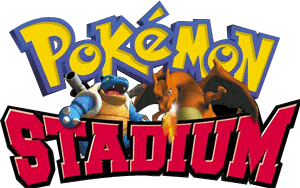Pokémon Stadium series: Difference between revisions
m (Bot: Modifying it:Pokémon Stadium (serie) to it:Serie Pokémon Stadium) |
YoungMan16 (talk | contribs) m (→Compatibility) |
||
| (6 intermediate revisions by 3 users not shown) | |||
| Line 29: | Line 29: | ||
| style="background:#{{kanto color dark}}; font-weight: bold" | {{color2|{{kanto color light}}|Generation I|I}} | | style="background:#{{kanto color dark}}; font-weight: bold" | {{color2|{{kanto color light}}|Generation I|I}} | ||
| style="height:75px" | [[File:Stadium EN boxart.jpg|75x75px]] | | style="height:75px" | [[File:Stadium EN boxart.jpg|75x75px]] | ||
| {{color2|000|Pokémon Stadium | | {{color2|000|Pokémon Stadium|Pokémon Stadium}} | ||
| {{color2|000|Pokémon Stadium | | {{color2|000|Pokémon Stadium|{{j|ポケモンスタジアム2}}<br>''<small>Pokémon Stadium 2</small>''}} | ||
| April 30, 1999 | | April 30, 1999 | ||
| February 29, 2000 | | February 29, 2000 | ||
| Line 49: | Line 49: | ||
==Compatibility== | ==Compatibility== | ||
{{main|Transfer Pak | {{main|Transfer Pak|section=Compatibility}} | ||
==In the ''[[Super Smash Bros.]]'' series== | ==In the ''[[Super Smash Bros.]]'' series== | ||
| Line 63: | Line 60: | ||
==Trivia== | ==Trivia== | ||
* [[Nickname]]d Pokémon in these games display slightly altered colorations when used in battle. Most opposing Trainers use nicknamed Pokémon to showcase this effect, which NPCs do not typically use otherwise. | |||
** The hue shifts are dependent on the Pokémon's nickname, the [[Original Trainer]]'s name, and the Original Trainer's [[Trainer ID number]], resulting in different hues between Pokémon of the same species with identical nicknames.<ref>[https://bluemoonfalls.com/pages/general/stadium-hues Stadium's Color Changing Pokémon - Blue Moon Falls]</ref> | |||
* These were the first games to color-code [[type]]s. The colors used in the Pokémon Stadium series were different than those that were introduced during [[Generation III]] in the [[core series]] Pokémon games (for example, {{t|Fire}} was red, not orange). | * These were the first games to color-code [[type]]s. The colors used in the Pokémon Stadium series were different than those that were introduced during [[Generation III]] in the [[core series]] Pokémon games (for example, {{t|Fire}} was red, not orange). | ||
* In these games, {{status|sleep}} had a maximum duration of 3 turns, as opposed to the handheld games, which had a maximum sleep duration of 7 turns. | * In these games, {{status|sleep}} had a maximum duration of 3 turns, as opposed to the handheld games, which had a maximum sleep duration of 7 turns. | ||
| Line 69: | Line 68: | ||
<references /> | <references /> | ||
{{Side series}} | |||
{{Side series}} | |||
{{Project Games notice}} | {{Project Games notice}} | ||
Latest revision as of 16:58, 17 September 2024
The Pokémon Stadium series (Japanese: ポケスタシリーズ PokéSta series[1], or 「ポケモンスタジアム」シリーズ "Pokémon Stadium" series[2]) is a side series of Pokémon games for the Nintendo 64 released during Generation I and Generation II and compatible with the games of those generations. In the games of this series, players can upload Pokémon from their Game Boy games to battle in 3D in various modes, most notably Stadium Mode, featuring various classes for Trainers to beat, and the Gym Leader Castle, featuring the Gym Leaders, Elite Four, and Champion of the respective generation's games. Players who did not have any core series games could still rent almost all 251 Pokémon at the time in certain modes.
List of games
| Gen. | Image | English title | Japanese title | Platform | Release date | |||
|---|---|---|---|---|---|---|---|---|
| Japan | North America | Europe | Australia | |||||
| I | 
|
— | ポケモンスタジアム Pokémon Stadium |
Nintendo 64 | August 1, 1998 | — | — | — |
| I | 
|
Pokémon Stadium | ポケモンスタジアム2 Pokémon Stadium 2 |
April 30, 1999 | February 29, 2000 | April 7, 2000 | March 23, 2000 | |
| II | 
|
Pokémon Stadium 2 | ポケモンスタジアム 金銀 Pokémon Stadium Gold and Silver ポケモンスタジアム 金銀 クリスタルバージョン |
December 14, 2000 | March 26, 2001 | October 10, 2001 | 2001 | |
Compatibility
- Main article: Transfer Pak → Compatibility
In the Super Smash Bros. series
A stage based on the Pokémon Stadium games, simply titled Pokémon Stadium, is featured in Super Smash Bros. Melee, and also appears in Super Smash Bros. Brawl as a Melee stage. Super Smash Bros. Brawl and Super Smash Bros. for Wii U also feature the Pokémon Stadium series-based Pokémon Stadium 2.
Trivia
- Nicknamed Pokémon in these games display slightly altered colorations when used in battle. Most opposing Trainers use nicknamed Pokémon to showcase this effect, which NPCs do not typically use otherwise.
- The hue shifts are dependent on the Pokémon's nickname, the Original Trainer's name, and the Original Trainer's Trainer ID number, resulting in different hues between Pokémon of the same species with identical nicknames.[3]
- These were the first games to color-code types. The colors used in the Pokémon Stadium series were different than those that were introduced during Generation III in the core series Pokémon games (for example, Fire was red, not orange).
- In these games, sleep had a maximum duration of 3 turns, as opposed to the handheld games, which had a maximum sleep duration of 7 turns.
References

|
This game-related article is part of Project Games, a Bulbapedia project that aims to write comprehensive articles on the Pokémon games. |


